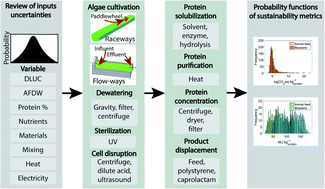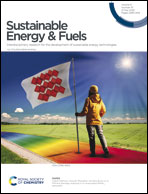Bioproducts from high-protein algal biomass: an economic and environmental sustainability review and risk analysis
Abstract
High-protein algal biomass is an important bio-commodity that has the potential to provide a new source of sustainable protein products. Herein is a critical review that identifies (1) the most relevant sustainability findings related to the processing of proteinaceous algal biomass to higher value protein products and (2) the potential pathways to improve life cycle assessment (LCA) and techno-economic analysis (TEA) metrics, including life-cycle carbon dioxide equivalent (CO2eq), life cycle energy, and minimum selling price (MSP) of these products. The critical review of the literature revealed a large variation in model input parameters relating to these metrics. Therefore, a Monte Carlo analysis was conducted to assess the risk associated with these input variations. To understand the uncertainties that propagate into high-protein algae to products' systems, we reviewed more than 20 state-of-the-art unit operations for algal biomass processing., including cell disruption, protein solubilization, protein precipitation and purification, and protein concentration. We evaluated displacement of proteinaceous products by algal-bioproducts, including ruminant feed, aquaculture feed, protein tablets, and biopolymers and biopolyesters, with prices in the market ranging from 1.9 to 120 $ kg−1 protein. This review realized that the MSP of ruminant and non-ruminant feed ranges from 0.65 ± 0.56 to 2.9 ± 1.1 $ kg−1 protein, and bioplastics' MSP ranges from 0.97 to 7.0 $ kg−1 protein. Regarding LCA metrics, there is limited research on life cycle energy in proteinaceous biomass concentration and bioproduct systems, reported at 32.7 MJ kgprotein−1, for animal feed displacement. Animal feed emissions in the literature report negative fluxes, representing environmental benefits, as low as −3.7 kgCO2eq kg−1 protein and positive fluxes, i.e., global warming potential, as high as 12.8 kgCO2eq kg−1 protein. There is limited research on bioplastics life cycle emissions reported at 0.6 kgCO2eq kg−1 protein. In general, the studies to date of algae-derived protein bioproducts showed similar life cycle emissions to soybean meals, nylon, polymers, and polystyrenes. Our risk analysis realized that more than 50% of scenarios can result in negative-net life cycle CO2eq emissions. This review and risk analysis assess and demonstrate the scenarios that improve economic and environmental sustainability metrics in high-protein algal bioproduct systems.

- This article is part of the themed collections: Sustainable Energy and Fuels Recent Review Articles and SDG12: Sustainable production of energy materials


 Please wait while we load your content...
Please wait while we load your content...
